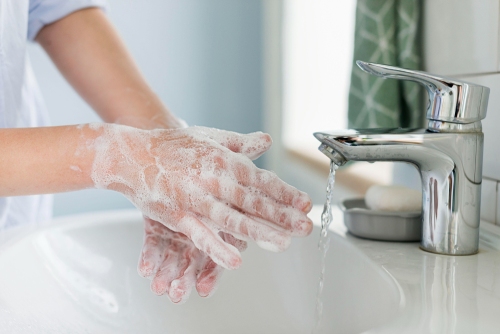Proper hygiene among employees in your commercial restaurant is very important to ensure food safety. Because the impact of foodborne illness can be devastating to both a restaurant and its customers, and due to the fact that it is a common occurrence in the United States, proper sanitation should not be taken lightly.
The Centers for Disease Control and Prevention (CDC) estimates that up to 36% of foodborne illness can be traced to poor personal hygiene and that foodborne diseases cause about 76 million illnesses, 325,000 hospitalizations and 5,000 deaths in the United States each year.
In many commercial restaurants, owners have shifted to having employees wear gloves while working in the kitchen. Several reasons have led to this shift including customers being more comfortable seeing employees wearing gloves and due to the health department prescribing employees to wear gloves and avoid bare-hand contact with ready-to-eat foods.
So, are gloves really more sanitary than washing hands?
The answer may surprise you. Generally, when people wear gloves it’s actually less sanitary than when they don’t wear gloves, with the exception of when employees have cuts or open sores on their hands. A hand-hygiene study was conducted by the CDC and found that hand washing rates were significantly lower when gloves were worn. This is due to the fact that gloves create a false sense of cleanliness, which ultimately leads to gloves being used incorrectly and employees not washing their hands well or as often as they should.
For example, if you were to grab a pickle with your bare hands, you’d get pickle juice on your hands. You’d proceed by washing your hands to get rid of the pickle juice. However, if you have gloves on and you grabbed a pickle, you more than likely would not change to a new pair of gloves before handling other food items since your hands are not physically wet from the juice. You can see why this would be a major problem, especially among multitasking line cooks.
So, what should you enforce in your kitchen?
A combination of a proper handwashing routine and proper use of disposable gloves is the best way to minimize risks associated with foodborne illness. It’s very important to stress that employees should change their gloves every time they touch a new food item or perform a new task such as placing food in a cooler.
In addition, they should wash their hands before placing every new pair of gloves on. Gloves alone will not prevent the problem without being used in combination with handwashing. Covering up contaminated hands is not the answer, removing the contamination first and then switching gloves frequently to eliminate cross contamination is.
Glove Tips:
- Have multiple sizes of gloves: It’s important to have gloves that fit all employees’ hand sizes. If gloves are too small they can tear, while gloves that are too big can fall off easily.
- Train employees with the proper glove removal technique. Visit CDC’s website for more information.
- Make sure employees are changing gloves at appropriate times. For example:
- If they tear.
- Before beginning a new task.
- Every four hours doing the same task.
- After handling raw meat, fish or poultry.
- Keep tabs on how many gloves are being used and step in the kitchen to make sure employees are changing their gloves and washing their hands at the appropriate times.
- Follow a general rule of thumb – Would you lick your gloves? With the exception of raw meats, the answer should be yes because if gloves are being used properly it wouldn’t be an issue.
- However, you would not want to lick a glove that has touched multiple different foods and surfaces around the kitchen.
Handwashing Tips:
- Train employees with the proper handwashing technique. Visit CDC’s handwashing resource page for more information.
- Make sure employees are washing their hands frequently and at the appropriate times. For example:
- Before starting work.
- Every time they change gloves.
- After treating a cut or wound.
- After using the toilet.
- After blowing their nose, coughing or sneezing.
- After touching garbage.
- Install proper handwashing stations in the kitchen and keep soap up to par.
- Consider additional hand sanitizers to be used as an added step.


